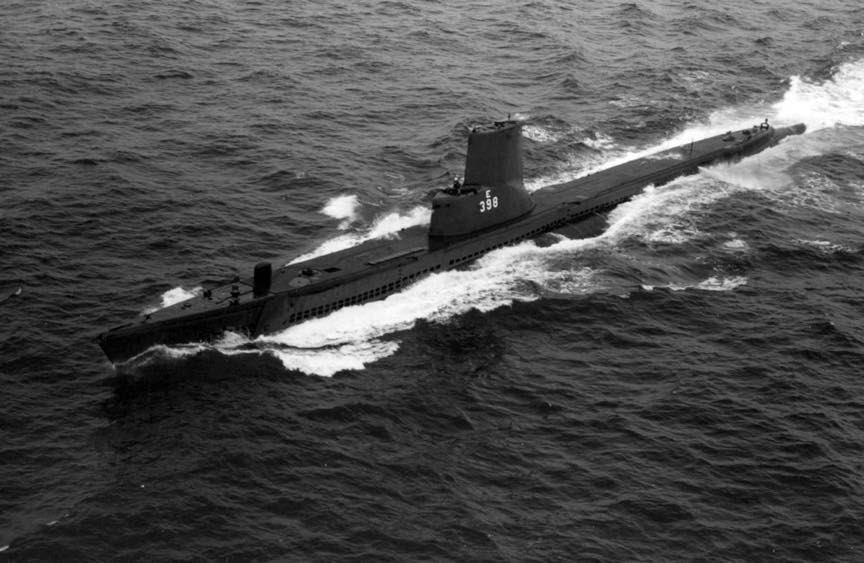Segundo SS-398
 Segundo
Segundo
(SS-398: dp. 1 525 (surf.), 2,415 (subm.), 1. 311'8";
b. 27'3"; dr. i5'3"; s. 20 k. (surf.), 8.75 k. (subm.)
cpl. 81; a. 10 21" tt., 1 5", 1 40mm., 1 20mm.; cl.
Balao )
Segundo (SS-398) was laid down on 14 October 1943 by the Portsmouth (N. H.) Navy Yard, launched on 5 February 1944; sponsored by Mrs. John L. Sullivan and commissioned on 9 May 1944, Lt. Comdr. J. D. Fulp, Jr., in command.
Segundo completed fitting out and contract trials then moved to New London, Conn., on 15 June and began training. The submarine stood out of New London on 26 June for the Panama Canal Zone en route to the Pacific war zone. She departed Balboa on 9 July and arrived at Pearl Harbor on 25 July. The next several weeks were spent in training exercises and weapons firing. The ship was combat loaded on 19 and 20 August and, the next day, sailed on her first war patrol.
Segundo, Seahorse (SS-304), and Whale (SS-239) formed a wolf pack. They refueled at Saipan on 3 September and departed the next day for their patrol area in the Philippines near Surigao Strait. No worthwhile targets were found, and Segundo ended her patrol at Majuro Atoll, Marshall Islands, on 21 October without having fired a shot.
The second patrol, from 16 November 1944 to 5 January 1945, was more profitable. Segundo, Trepang (SS-410), and Razorback (SS-394) were cruising between Luzon Strait and the South China Sea. On the evening of 6 December, a convoy of seven escorted merchant ships was sighted. The three submarines made night attacks which sank all of the merchantmen.
Segundo refitted at Guam from Apollo (AS-25) and was in the East China Sea with Seacat (SS-399) and
Razorback on 1 February. Three torpedo attacks were made on unescorted ships near the Korean coast in shallow water. The first attack was on 6 March against a small ship but all torpedoes missed. The next was made four days later against a medium-sized ship. Four torepdoes were fired at 1,000 yards but they also missed. The third attack was a night surface one against a cargo ship on 11 March. Two torpedoes of the spread hit. The first blew the stern off and the second hit amidships, sinking Shori Maru in two minutes. The submarine ended her patrol at Pearl Harbor on 26 March and remained there for a month before putting to sea again.
Segundo was assigned to a lifeguard station until 16 May when she departed for her assigned area in the East China Sea. On the 29th, she sank seven twomasted schooners of approximately 100 tons each with shellfire. Two days later, she sank a large four-masted full-rigged ship of approximately 1,250 tons with two torpedoes. She sank another on 3 June with her deck gun. On the 9th, two patrol ships were also sunk by her deck gun. On the night of 11 June the Fukni Maru was torpedoed and sank. The submarine then sailed to Midway for upkeep.
Segundo began her fifth and final war patrol on 10 August in the Sea of Okhotsk. Ordered to proceed to Tokyo Bay on the 24th, the ship was proceeding south when she picked up a Japanese submarine by radar on the 29th. The enemy boat was ordered to halt by international signal. This was done; and, after several trips between the two submarines by their respective representatives, the Japanese agreed to accept a prize crew aboard and to proceed to Tokyo with Segundo. The two ships entered Sagami Wan on 31 August and, at 0500, the American flag was raised aboard the l-401.
Segundo stood out of Tokyo Bay on 3 September 1945 en route to the west coast via Pearl Harbor. She was assigned to Submarine Squadron (SubRon) 3 in San Diego and began operations from there. The submarine made a three-month cruise to Australia and China in 1946 and a four-month cruise to China in 1948. The outbreak of war in Korea found Segundo in the Far East. She supported United Nations Forces in Korea from July to September 1950 before returning to San Diego in late November.
In 1951, Segundo was modernized at the San Francisco Naval Shipyard and equipped with a snorkel. She returned to her home port and resumed operations until 15 August 1952 when she again joined the 7th Fleet off Korea. That deployment period ended on 16 February 1953.
For the next 16 years, Segundo operated out of her home port and along the west coast. From 1953 through 1969, she was deployed to the western Pacific every year except 1956, 1957, 1961, and 1963.
In July 1970, a Survey Board found Segundo unfit for further Naval service. The submarine was struck from the Navy list on 8 August 1970 and sunk as a target.
Segundo received four battle stars for World War II service and one for the Korean War.
